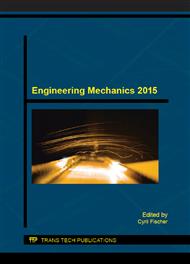[1]
ACI 349-90, 1990. Code Requirements for Nuclear Safety Related Concrete Structures, American Concrete Institute, Detroit.
Google Scholar
[2]
Bažant, Z. P. Pang, S. D. Vořechovský, M. and Novák. D. Energetic-statistical size effect simulated by SFEM with stratified sampling and crack band model. International Journal for Numerical Methods in Engineering (Wiley), 71(11): 1297-1320, 2007, Rep. Dept. of Civil Eng., Northwestern University, Evanston, Illinois.
DOI: 10.1002/nme.1986
Google Scholar
[3]
BNSI, Requirements for the study of PSA, BNSI. 4. 2. ( 2006).
Google Scholar
[4]
Brožovský, J. Konečný, P. Mynarz M. Sucharda, O. Comparison of Alternatives for Remodelling of Laboratory Tests of Concrete, In Proceedings of the Twelfth International Conference on Civil, Structural and Environmental Engineering Computing, B.H.V. Topping, L.F. Costa Neves, R.C. Barros, (Editors), Funchal: Civil-Comp Press (Stirlingshire), paper 119, 2009. ISBN 978-1-905088-30-0.
DOI: 10.4203/ccp.91.119
Google Scholar
[5]
CEB-FIP Model Code 1990, Design Code, Thomas Telford, ISBN 0727716964.
Google Scholar
[6]
Červenka, V. Constitutive Model for Cracked Reinforced Concrete, ACI Journal 82, 877, (1985).
Google Scholar
[7]
ENV 1992-1-1. Eurocode 2: Design of Concrete Structures, Part 1, Brussels: CEN (1992).
Google Scholar
[8]
ENV 1992-1-2. Eurocode 2: Design of Concrete Structures - Part 1-2 Fire Résistance of Concrete Structures, CEN (1997).
Google Scholar
[9]
HANBOOK 5. Implementation of Eurocodes Reliability Backgrounds. Design of Buildings for the Fire Situation. Development of Skills Facilitating Implementatio of Eurocodes. Leonardo Da Vinci Pilot Project CZ/02/B/F/PP-134007. Prague, CR, 10. (2005).
Google Scholar
[10]
Haldar, A. and Mahadevan, S., Probability, Reliability and Statistical Methods in Engineering Design, John Wiley & Sons, New York. (2000).
Google Scholar
[11]
IAEA- SSG-4, Development and Application of Level 2 - Probabilistic Safety Assessment for Nuclear Power Plants. (2010).
Google Scholar
[12]
JCSS 2011. JCSS Probabilistic Model Code. Zurich: Joint Committee on Structural Safety. <www. jcss. byg. dtu. dk>.
DOI: 10.1016/s0167-4730(97)00008-8
Google Scholar
[13]
Jerga, J. and Križma, M., Assessment of Concrete Damage, Building Research Journal 54, p.211. (2006).
Google Scholar
[14]
Kohnke, P., ANSYS, Theory, SAS IP Inc. Canonsburg. (2008).
Google Scholar
[15]
Kolmar, W., Beschreibung der Kraftübertragung über Risse in nichtlinearen Finite-Element-Berechnungen von Stahlbeton-Tragwerken, PhD Thesis, T.H. Darmstadt, Darmstadt. (1986).
Google Scholar
[16]
Králik, J., Safety and Reliability of Nuclear Power Buildings in Slovakia. Earthquake-Impact-Explosion. Monograph. Published by STU Bratislava, 307pp. ISBN 978-80-227-3112-6. (2009).
Google Scholar
[17]
Králik, J., Nonlinear Probabilistic Analysis of the Reinforced Concrete Structure Failure of a Nuclear Power Plant Considering Degradation Effects. In: Applied Mechanics and Materials Vols. 249-250 (2013).
DOI: 10.4028/www.scientific.net/amm.249-250.1087
Google Scholar
[18]
Králik, J. et al. Structural Reliability for Containment of VVER 440/213 Type, In Safety and Reliability: Methodology and Applications - Nowakowski et al. (Eds) © 2015 Taylor & Francis Group, London, pp.2279-2286.
DOI: 10.1201/b17399-312
Google Scholar
[19]
Novák, D. Bergmeister, K. Pukl, R. Červenka, V. Structural assessment and reliability analysis for existing engineering structures, Theoretical background. Structure and infrastructure engi-neering, Vol. 9, No. 2, 2009, pp.267-275.
DOI: 10.1080/15732470601185612
Google Scholar
[20]
NUREG/CR-7031, A Compilation of Elevated Temperature Concrete Material Property Data and Information for Use in Assessments of Nuclear Power Plant Reinforced Concrete Structures, ORNL/TM-2009/175, US NRC. (2010).
Google Scholar
[21]
SCHNEIDER, U. & SCHWESINGER, P. Mechanical Testing of Concrete at High Temperature, RILEM-U, Kassel - U. Weimar, Kassel, 1990, pp.20-21.
Google Scholar
[22]
Sucharda, O. Brožovský, J. Mikolášek, D. Numerical Modelling and Bearing Capacity of Reinforced Concrete Beams. Key Engineering Materials, 2014, pp.281-284.
DOI: 10.4028/www.scientific.net/kem.577-578.281
Google Scholar


